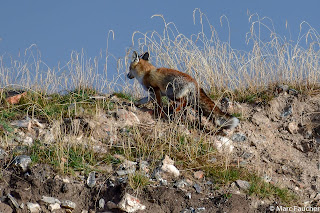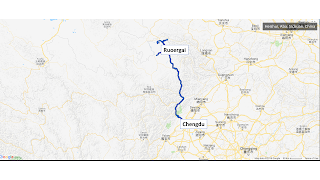On September 25 we flew from Ulaanbaatar, Mongolia to Chengdu, China via Beijing for the next leg of our journey. We had arranged a private trip to the Ruoergai Grasslands in Sichuan Province with local guide Sid Francis. Sid picked us up early the following morning for the long drive to Ruoergai on the eastern edge of the Tibetan Plateau. Along the way, we were amused by the many camps set up to house the throngs of Chinese tourists that would be visiting the plateau during Golden Week, the 7-day national holiday celebrated the first week of October. City folks could get the feel of sleeping in a tent, riding a horse or petting a yak!
 |
| Tourist Camp |
We arrived in the town of Ruoergai and settled into our comfortable hotel for a 5-day stay. Even after the long drive, we were keen to go off in search of mammals so we drove another 45 minutes north of town to the site of an old rock quarry to look for wild cats. None were around so we headed further north and turned off onto a cement track that led through grasslands to a pass. Amazingly we picked up the eyeshine of many animals: Tibetan Fox, a Pallas’s Cat, a Chinese Mountain Cat, and even a lone Tibetan Wolf! The predators were here but the distance and darkness made viewing and photographing them difficult. We’d have to return in the morning light.
We returned the following morning but fog and drizzle now hampered our ability to spot animals. We did see hundreds of Plateau or Black-lipped Pikas scurrying around their burrows and even a few Himalayan Marmots that had not yet hibernated for the winter. With all this potential prey, no wonder there were so many predators out last night.
We returned to Ruoergai for lunch and headed out in the evening to spotlight along a road to the west of town. Unusually high traffic made it tricky but Sid spotted the eyeshine of a feline in the grass. We got out to investigate and after climbing over a few fences we were able to approach the cat to within 10 meters. We could clearly see that it was a Chinese Mountain Cat, a feline endemic to China! Larger than a domestic cat and with tufted ears, the Chinese Mountain Cat inhabits the grasslands and deserts on the northeastern edge of the Tibetan Plateau. Until 2007, the Chinese Mountain Cat was known only from six individuals, all living in Chinese zoos, and a few skins in museums. What a treat to get so close to this mysterious cat!
 |
| Black-lipped Pika |
 |
| Himalayan Marmot |
Early the next morning we returned to the rock quarries to look for more cats. We didn’t find any but we flushed three Red Foxes from their hiding spots in a second, more distant quarry.
We continued to the one-lane cement track which I had dubbed “Canyon Road” since from the pass it leads down into a narrow canyon. The weather had greatly improved and today we got great views of the surrounding mountains from the top of the pass. Sid spotted some Blue Sheep on a distant ridge.
 |
| View from the Pass |
We headed down into the canyon not seeing many mammals but enjoying the many birds flitting about in the trees. The canyon narrowed to high rock walls adorned with Buddhist prayer flags and paintings.
We reached a tiny village where elderly Tibetans sat spinning their prayer wheels in the morning sun. It was nice to see that they were allowed to practice their religion which at one time was discouraged in China.
 |
| Tibetans in Village |
In fact, we were surprised to see that many new chortens and temples had been built in the valley. On the way back we stopped to visit a Buddhist monastery that had recently been constructed. A lone monk invited us inside. Although the building was new many artifacts inside appeared ancient.
By this time it had gotten quite late and we decided to visit a third rock quarry before returning to Ruoergai. As dusk began to fall, 11 female Tibetan Gazelle appeared from the ridges above and approached quite closely. They were followed by a lone male, possibly staking out females in preparation for the upcoming rut.
 |
| Tibetan Gazelle |
A very early start the following morning didn’t yield much mammal-wise so we returned to Ruoergai for some much-needed downtime. We headed out in the afternoon but our ability to drive north was hampered by road construction. After a 5-hour delay, we were finally on our way. It had started to rain and I wanted to return to Ruoergai. There was so much oncoming traffic that we had no choice but to continue north. Finally, we reached the turnoff for “Canyon Road” and by this time it had stopped raining. Things were looking up. Soon after we picked up the eyeshine of a mammal. It was our first Asian Badger! But, it wasn’t alone. It was being harassed by two Tibetan Foxes. Sid thought that the foxes follow the badger waiting for it to dig up a tasty pika and then steal its meal. What crafty foxes! We tried to get closer on foot for a better view but the trio moved off after this photo:
A bit further down the road, Sid picked up the eyeshine of an animal sitting on the top of a ridge. It was a Pallas’s Cat, possibly the same one we had seen on our first night. We climbed to the top of the ridge to investigate, reaching the hollow where the cat had been sitting but it had left. Continuing down the road we detected the eyeshine of three more animals. A look through Sid’s spotting scope revealed a mother Pallas’s Cat and her two nearly grown kittens! They were hanging out on a rock about halfway up the ridge.
We proceeded carefully on foot to get a closer look. The kittens were very curious but mom had slinked off. We were able to get to within 10 meters for some wonderful views and photos. We didn’t go any closer not wanting to disturb the cats further. Wow, four Pallas’s Cats in one night!
 |
| Pallas's Cat Kittens |
We continued up the road and down into the canyon. We were on the search for nocturnal squirrels that inhabit the forest. On the way, we encountered two Siberian Roe does and further along this impressive Sika stag grazing next to the road.
Our search for the squirrels paid off as we spotted three Chinese Giant Flying Squirrels high up in the conifers. Marc was able to get a photo of one.
On the drive back we spotted what we thought was a pack of Tibetan wolves but it turned out to be another Asian Badger being harassed by three Tibetan Foxes. Maybe this was the same group we had seen on the drive in but these were on the other side of the road so we speculated that they were different. Again we tried to get closer on foot but failed.
We slept in the following morning as we didn’t return to the hotel until 2:00 am from our “lamping” session the night before. Around noon we headed north back to “Canyon Road”. We drove past the rock where we had seen the Pallas’s Cat family but it was surrounded by domestic yaks. The fact that so many predators coexist with domestic animals including dogs and their herders was a surprise to me.
 |
| Domestic Yaks around "Pallas's Cat Rock" |
We decided to head even further north to a massive Plateau Pika colony. On the way, we were sad to see thousands of skinned Chinese Zokor hanging to dry. Apparently, the Chinese government thinks it’s a good idea to trap and kill these burrowing rodents, believing they destroy the grasslands. The weather had deteriorated and by the time we reached the pika colony, it had begun to snow. We didn’t see much except for a few Black-necked Cranes braving the storm.
 |
| Chinese Zokor Carcasses |
The next morning we left the Tibetan Plateau making one last stop at Baixi. On the drive in I spotted an animal on the grasslands about a kilometer off the road. It was one of a pack of five Tibetan Wolves that had just killed a Tolai Hare!
We also spotted a Chinese Serow grazing on a ridge above and some great birds like this beautiful Gray-headed Bullfinch.
 |
| Gray-headed Bullfinch |
We returned to the main road for the long drive to Dujiangyan. We followed the Minjiang River hoping that the detour we had encountered on the way in had been cleared. Not seeing any road closure signs we proceeded on the main road, unfortunately, hitting the roadblock once again. We were forced to backtrack and follow the detour high above the river.
We arrived in Wenchuan after dark and stopped for dinner. This city had been destroyed in the 2008 Sichuan earthquake during which 69,000 people lost their lives. The city has been rebuilt in Las Vegas-style with a lot of gaudy lights.
We arrived in Dujiangyan in time for bed. On our last day with Sid, we decided to visit the nearby Panda Center. Although I’d prefer to see Giant Pandas in the wild, this is now difficult since the Chinese government has closed the Wolong Panda Reserve to foreigners. At least we were able to see Giant Panda in their native country and hope that one day these bears will be released into the wild.
 |
| Giant Panda |
A big thanks to our wonderful guide Sid for showing us the splendors of the Ruoergai Grasslands! In a fast-changing world, we hope that the unique mammals that make the Tibetan Plateau home will continue to coexist with their human neighbors.
We hope all is well with everyone,












1 comment:
Excellent report with superb images - wish the Badger was closer for Marc to get a nice image.
Post a Comment